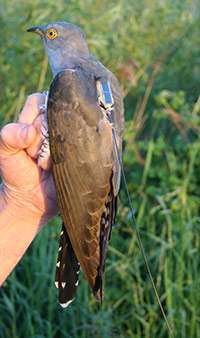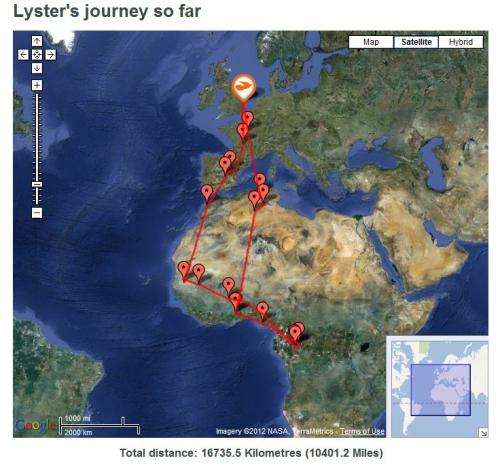May 7, 2012 report
British ornithologists track cuckoo birds migration route

(Phys.org) -- Nowhere it seems, are bird watchers more enthusiastic than in Britain, where groups congregate to watch and discuss the most intimate details of their favorite fowl. Of consternation to such groups however is the decline of several favorite species, one of which is the cuckoo, which has seen a nearly fifty percent drop in numbers in just the past couple of decades. Making matters even more frustrating has been the lack of data on the birds which might offer clues as to why their numbers are dropping. Now, one group, the British Trust for Ornithology (BTO) has taken matters into its own hands by capturing and fitting five wild cuckoos with tiny radio backpacks to allow for tracking of the birds during their annual migration. The hope is that by tracking the birds to see where some die, efforts can be made to help them survive.
The group not only tagged the birds with backpacks, which cost about £2,000 each, but also named them (Lyster, Chris, Clement, Martin and Kasper) and allowed others to track their journey via Google Maps. Unfortunately, only two of the group managed to survive the journey (Lyster and Chirs, though there is still some hope for Kasper) from Norfolk in England to the Congo and back, but the collars did provide a clear map of the migration routes of the birds, which oddly, were quite different for each bird, even as they all ended up in nearly the same place for their winter stay.

All of the birds made it to the Congo, it was in coming back that they ran into trouble. To do so, they have to stop and fill up twice; once before crossing the Sahara desert, then again before crossing the Mediterranean Sea. And though the test was of just of one small group migrating once, BTO members are already hypothesizing that it’s possible the birds might be finding it more difficult to fill up properly before crossing the big hazards, than in years past, which would account for fewer of them surviving the trip north.
One surprise the group found was that the cuckoos all veered slightly west, towards Cameroon, before heading due north, for the return trip, which shouldn’t have been a surprise after all, as that allows for traveling over the narrowest part of the desert. There are other hazards as well though, they found, one bird, Martin apparently met his demise after wandering into a violent hail storm.
Despite the losses, the team views the study as a success. Much more is now known about the migration of the cuckoo bird and because of that, some efforts might begin to help more of the birds survive the round trip each year, thus preventing them from disappearing altogether.
More information: www.bto.org/science/migration/ … yster/finding-lyster
© 2012 Phys.Org



















